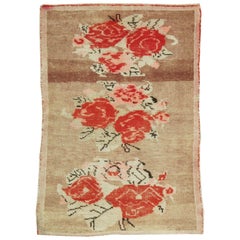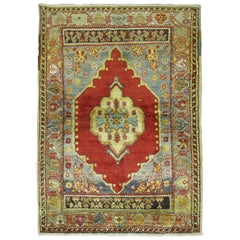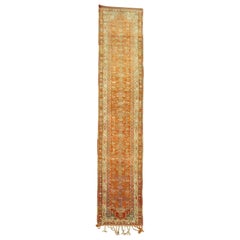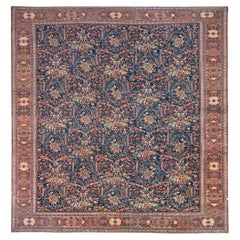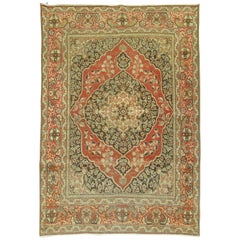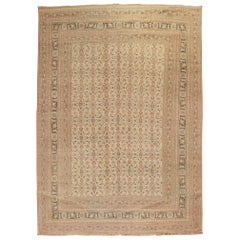Manhattan - More Carpets
to
764
Width
to
Length
to
3,927
758
61
445
200
113
78
64
64
33
20
20
18
12
10
2
2
2
39
471
3,417
819
1,351
1,242
150
56
44
107
62
29
60
42
32
8
5
4,707
4,507
312
128
35
4,746
24,784
3,138
4,746
4,679
4,741
4,164
3,422
2,058
1,364
1,234
117
63
39
8
8
Item Ships From: Manhattan
Vintage Turkish Anatolian Rug
Located in New York, NY
A vintage Turkish Anatolian rug from the mid-20th century.
Measures: 2' 2" x 3' 1"
Category
Mid-20th Century Turkish Folk Art Manhattan - More Carpets
Materials
Wool
$900 Sale Price
20% Off
Zabihi Collection Red Antique Turkish Oushak Scatter Rug
Located in New York, NY
A scatter-sized antique Turkish Oushak rug
3'6'' x 4'10''
Category
Mid-20th Century Turkish Tabriz Manhattan - More Carpets
Materials
Wool
$2,000 Sale Price
20% Off
Orange Color Vintage Turkish Anatolian Runner
Located in New York, NY
Vintage one of a kind Turkish Anatolian runner with a geometric design in a predominant orange color.
Measures: 2'11" x 15'2".
Category
1940s Turkish Bohemian Vintage Manhattan - More Carpets
Materials
Wool
Navy Oversize Square Persian Mahal Traditional Wool Oriental Rug
By Ziegler & Co.
Located in New York, NY
Rare oversize square Persian Mahal rug with all-over mustafi design on a navy field background,
circa 1910, measures: 17'8" x 19'1".
Category
Early 20th Century Persian American Colonial Manhattan - More Carpets
Materials
Wool
Early 20th Century Antique Persian Tabriz Rug
Located in New York, NY
An early 20th century authentic antique Persian Tabriz rug.
3'9'' x 5'2''
Category
Early 20th Century Persian Restauration Manhattan - More Carpets
Materials
Wool
$2,000 Sale Price
20% Off
Zabihi Collection Antique Persian Tabriz Rug
Located in New York, NY
An early 20th century antique Persian Tabriz rug. Ivory field, terracotta/burnt orange accents.
Measures: 7'9'' x 11'3''.
Tabriz rug weavers drew on a varied repertoire of deli...
Category
Early 20th Century Persian Restauration Manhattan - More Carpets
Materials
Wool
Mid-20th Century, Handmade Persian Malayer Accent Rug
Located in New York, NY
A vintage Persian Malayer accent rug handmade during the mid-20th century.
Measures: 4' 3" x 6' 5".
Category
Mid-20th Century Persian Rustic Manhattan - More Carpets
Materials
Wool
Vintage Trapezoid Persian Rug Persian Ghom Rare Collector 1950
Located in New York, NY
Rare Vintage Fine Qouum Kork Wool Rug
Trapezoid
Gold
3'10" x 4' x 2'3"
Circa 1950
"This is an exceptionally fine authentic Persian Kork Wool trapezoid shape rug. It i...
Category
1950s Persian Vintage Manhattan - More Carpets
Materials
Wool
$2,389 Sale Price
20% Off
Contemporary Handmade Pictorial Room Size Rug of a Resting Lion
Located in New York, NY
A modern Afghan pictorial room size rug handmade during the 21st century with a lion resting over a green field.
Measures: 8'4" x 10'0".
Category
21st Century and Contemporary Afghan Folk Art Manhattan - More Carpets
Materials
Wool
$5,400 Sale Price
20% Off
Fine Antique Turkish Sivas Rug
Located in New York, NY
Antique Turkish Sivas rug in reds, brown, blues and mustard.
3'10'' x 6'
Category
20th Century Turkish Agra Manhattan - More Carpets
Materials
Wool
$2,200 Sale Price
22% Off
Zabihi Collection Square Antique Turkish Oushak Rug
Located in New York, NY
An early 20th-century Turkish Oushak in gray and lavender.
11'1'' x 12'6''
Category
Early 20th Century Turkish Country Manhattan - More Carpets
Materials
Wool
Zabihi Collection Brown Color Open Field Turkish Anatolian Square Mini Rug
Located in New York, NY
Weather textured Turkish Anatolian small square rug from the mid-20th century.
Measures: 2'4" x 2'7".
Category
20th Century Turkish Minimalist Manhattan - More Carpets
Materials
Wool
$375 Sale Price
44% Off
Early 20th Century Handmade Turkish Oushak Runner
Located in New York, NY
An antique Turkish Oushak rug in runner format handmade during the early 20th century.
Measures: 2' 8" x 10' 9"
Turkish rugs & carpets:
Until the Great Persian Carpet Revival in the later 19th century, the “Oriental rug” was Turkish. For nearly six centuries, Turkish rugs, both scatter, room size, and even larger, thoroughly dominated the European import market. Whereas the Persian carpet can be divided into urban, village, and tribal types, in Turkey and its predecessor the Ottoman Empire, rugs almost exclusively came from village weavers and from a small number of urban workshops. Ninety percent village, nine percent city, one percent tribal.
Turkish weavers have, with very few exceptions, always worked with the symmetric (Turkish) knot. Wool foundations are standard practice among both town and village weavers. The exceptions, very finely woven 20th century and recent Herekeh silks from near Istanbul, and early 17th century Ottoman Court rugs from Bursa, constitute only a tiny part of the total. Always pricey, they appealed and still appeal to the clients who want lots of knots and perfect execution instead of individual personality.
The urban workshops have been centered around the western Turkish city of Oushak and its attendant port town of Smyrna. Oushak weaves with the trends in fashion. When color saturated medallion carpets were needed, Oushak was ready in the 17th and 18th centuries. When coarse red and blue carpets were required, Oushak and Smyrna in the 19th century wove them by the boatload. When tastes changed again, and the European dealers in Smyrna wanted room size carpets with lighter and unusual colors, and with Persianate designs, production ramped up in nearby Oushak. Those antique, all-wool construction turn-of-the-century carpets are still in high demand with designers. Antique carpets with allover, roughly drawn patterns on grounds of shrimp, rust, straw, cream, pale blue, and pale and pea green, hitherto unavailable colors, are in such demand today that contemporary Oushaks have attempted to mimic them with soft palettes, extra-large scale drawing and coarse weaves.
Oushaks woven for the Turkish market, for palaces, houses and mosques were often oversize with large, repeating medallions, all in shades of (Turkey) red, dark blue, light blue-teal, and ivory, with lemon and green accents. Turkey, along with India, invented standard sizes. By vertically repeating the medallion, one could get one medallion, one with two end halves, two, three, etc. medallions, up to thirty or so feet in length. The process spared making new cartoons for each length and allowed a quicker turnaround time. Oushak, from the time of 15th century “Holbein” rugs onward, has always been a commercial center.
The prayer niche directional rug is primarily a Turkish development. In the towns and villages east of Oushak, in Ghiordes, Kula, Ladik, Kirsehir, Mucur and Konya, among others, arch pattern scatters with bright palettes and weaves varying from relatively fine to moderate were almost the entire production. Antique examples were particularly popular in America around 1900.
Other centers of village weaving were situated on the western coast and adjacent islands with the town of Melas and neighboring villages weaving geometric prayer rugs and scatters with a characteristic khaki green and lots of yellow.
The other large region was in the northwest of Anatolia, near ancient Troy, with the sizable town of Bergama at its center. The satellite towns of Ezine, Karakecilli, Yuntdag, and Canakkale all wove colorful scatters with moderate weaves in all wool with geometric designs and cheerful palettes. Near to Istanbul, these were among the first Turkish rugs to reach Europe in the Renaissance.
The earliest Turkish pieces depicted in Italian Old Master paintings display the so-called “Memling gul”, an allover panel pattern with hooked and stepped elements within the reserves. This pattern continues for centuries in the Konya area and in the Caucasus as well.
Turkey is a land of villages and much of the most interesting Turkish weaving comes from one undiscovered village or another. The Konya-Cappadocia region of central Turkey includes the active towns of Karapinar, Karaman, Obruk, Sizma, and Tashpinar, all weaving Konya-esque scatters and long rugs. Karapinar has been active the longest, since the 17th century. The mosques in and around Konya have preserved locally-made rugs from the fourteenth. In the 20th century, the extra-long pile, many wefted Tulu rug was devised, with limited palettes and color block patterns. These are not really antique Tulus, but they must be a product of long-standing village tradition.
There are thousands upon thousands of rural Turkish villages, almost all with easy access to local tribal wool. Rug students are discovering new names and rug types almost daily. The common denominators are bright colors, geometric designs, wool construction, moderate to coarse weaves and symmetric knots. Synthetic dyes hit the Turkish rug industry quickly and hard after 1870, and they penetrated to even the most off-the-beaten-track villages. This development was almost entirely negative. The village weavers used fugitive or overly bright dyes which ruined the color harmonies built up over centuries. Characteristic types disappeared or were negatively transmuted. The Turkish village rug of the 1870 to 1920 period is nothing to be proud of.
In the eastern provinces, the semi-nomadic Kurdish tribes, collectively called ‘Yuruks’, weave all wool, geometric pieces with medium to medium-coarse weaves, as well as kilims and other flatweaves. The rugs employ cochineal instead of madder for the reds, mustard yellows, greens, and various blues. They are under-collected like the Persian Afshars. Their rugs are in scatter and long rug formats. The far eastern Turkish town of Erzerum has a long tradition of idiosyncratic, semi-workshop rugs and further to the east is Kars with a tradition of rugs in the Caucasian Kazak manner.
One Turkish specialty is the Yastiks or cushion cover, made in pairs for the public living rooms of village houses. These are larger rugs in miniature and good ones are highly collectible. Like other Turkish rustic weavings, ones with synthetic dyes are almost totally undesirable. Only the tribal Baluch make similar cushion covers, known as pushtis or balishts, in the same small, oblong format. Yastiks always have a back, usually in plain weave, so that they can be easily stuffed.
When the Imperial Carpet Factory at Herekeh near Istanbul closed in the early 20th century, the highly proficient Armenian master weavers set up in the Kum Kapi district of Istanbul where they wove all-silk, exquisitely fine and elaborately detailed small pieces, sometimes enriched with metal thread, for the most discriminating European buyers. Today the best, signed Kum Kapi pieces, usually in the “Sultan’s head” prayer niche design, can fetch upwards of $100,000. They are strictly for the wall. An Interwar all-silk room size Kum Kapi carpet is both exceedingly rare and stratospherically priced. The workshops closed in the 1930s, but the weaving of extremely fine, all-silk small rugs in Herekeh was revived in the 1960s.
There has been a recent vogue for larger Turkish village vintage...
Category
Early 20th Century Turkish Modern Manhattan - More Carpets
Materials
Wool
Zabihi Collection Antique Russian Caucasian Baku Rug
Located in New York, NY
A connoisseur caliber late 19th century Caucasian Baku carpet. This piece does have some characteristics that you see in Persian rugs but we believe it was woven in the caucuses. Glo...
Category
Late 19th Century Caucasian Kazak Antique Manhattan - More Carpets
Materials
Cotton, Wool
$10,000 Sale Price
33% Off
1880 Aubusson Flatwoven French Aubusson Napoleon III
Located in New York, NY
Fine Napoleon III Aubusson Authentic French Aubusson 1880
5'5" x 9'
165cm x 275cm
"This is a magnificent pre-1900 antique Napoleon III Fren...
Category
1880s French Antique Manhattan - More Carpets
Materials
Wool
$6,600 Sale Price
20% Off
Moroccan Rug
Located in New York, NY
Category
21st Century and Contemporary Moroccan Manhattan - More Carpets
Materials
Wool
$5,800 Sale Price
22% Off
Antique Persian Serapi Rug. Size: 9 ft x 11 ft 6 in
Located in New York, NY
Antique Persian Serapi Rug, Country of origin / rug type: Persian rugs, Circa date: 1900. Size: 9 ft x 11 ft 6 in (2.74 m x 3.51 m)
Category
20th Century Persian Heriz Serapi Manhattan - More Carpets
Materials
Wool
Vintage Red Turkish Rug
Located in New York, NY
One of a kind vintage Turkish runner with a all-over borderless design with running circles on a sweet red ground.
4'8'' x 9'10''
Category
20th Century Turkish Gustavian Manhattan - More Carpets
Materials
Wool
$2,800 Sale Price
20% Off
Mid-20th Century Handmade Persian Mashad Art Deco Square Accent Rug
Located in New York, NY
A vintage Persian Mashad Art Deco square accent rug handmade during the mid-20th century.
Measures: 4' 11" x 5' 9".
Category
Mid-20th Century Persian Art Deco Manhattan - More Carpets
Materials
Wool
Contemporary Handmade Flayed Man Tantra Accent Rug
Located in New York, NY
A modern Afghan Tantra rug with a pictorial depiction of a flayed man handmade during the 21st century.
Original versions were employed by Vajrayana Budd...
Category
21st Century and Contemporary Afghan Folk Art Manhattan - More Carpets
Materials
Wool
$4,300 Sale Price
20% Off
Brown Beige Turkish Oushak Runner
Located in New York, NY
Narrow and long tone on tone Turkish Oushak runner. Small hints of green that can barely be seen,
circa mid-20th century, measures: 2'8" x 13'5".
Category
20th Century Turkish Modern Manhattan - More Carpets
Materials
Wool
Earth Color Turkish Deco Rug
Located in New York, NY
Intermediate size one of a kind midcentury Turkish Deco rug with earth accents in khaki, denim blue, and brown,
circa mid-20th century/ measures: 5'7” x 8'9”.
Category
Mid-20th Century Turkish Mid-Century Modern Manhattan - More Carpets
Materials
Wool
Vintage Art Deco Indian Rug. Size: 12 ft 7 in x 18 ft 7 in
Located in New York, NY
Vintage Art Deco Rug, Country Of Origin: India, Circa date: Early 20th century. Size: 12 ft 7 in x 18 ft 7 in (3.84 m x 5.66 m)
Category
Early 20th Century Indian Art Deco Manhattan - More Carpets
Materials
Wool
16th Century Antique Flemish Tapestry. 10 ft 8 inx 11 ft 3in
Located in New York, NY
16th Century Antique Flemish Silk And Wool Biblical Scene Tapestry, Country Of Origin: Belgium, Circa Date: 16th Century. Size: 10 ft 8 in x 11 ft 3 in (3.25 m x 3.43 m)
Category
16th Century Belgian Renaissance Antique Manhattan - More Carpets
Materials
Wool, Silk
Antique Persian Tabriz Rug
Located in New York, NY
Since the 17th century, Iran started exporting artisan carpets around the world, especially to Europe. Artists used one of the three versions of vertical looms later referred to as a...
Category
Early 20th Century Persian Manhattan - More Carpets
Materials
Wool
$18,500
Mid-20th Century Handmade Persian Pictorial Bakhtiari Accent Rug
Located in New York, NY
A vintage Persian pictorial Bakhtiari accent rug handmade during the mid-20th century.
Measures: 4' 8" x 7' 6".
Category
Mid-20th Century Persian Tribal Manhattan - More Carpets
Materials
Wool
Palace Size Salmon Antique Oushak Carpet
Located in New York, NY
An enormous antique Turkish Oushak rug with a very interesting turquoise shade with a caramel center medallion set on a salmon ground. In pretty good condition which is uncommon for ...
Category
Early 20th Century Turkish Edwardian Manhattan - More Carpets
Materials
Wool
Zabihi Collection Antique Tribal Serapi Heriz Runner
Located in New York, NY
Am authentic one-of-a-kind antique Persian serapi Heriz wide runner in rustic tones.
3'5'' x 15'4''
Category
Early 20th Century Persian Serapi Manhattan - More Carpets
Materials
Wool
Mid-20th Century Handmade Chinese Art Deco Room Size Carpet
Located in New York, NY
A vintage Chinese Art Deco room size carpet handmade during the mid-20th century.
Measures: 9' 2" x 11' 7".
Category
Mid-20th Century Chinese Art Deco Manhattan - More Carpets
Materials
Wool
19th Century French Needlepoint Carpet ( 17'6" x 19' - 533 x 599 )
Located in New York, NY
This mosaic floor pattern wool needlepoint carpet was clearly a special commission for a high-level Roman Catholic ecclesiastic, bishop and then archbishop / cardinal as indicated by the hats with tassels in the corners, each surmounting a shield of arms...
Category
1870s French Antique Manhattan - More Carpets
Materials
Wool
Early 20th Century Handmade Persian Lavar Kerman Gallery Carpet
Located in New York, NY
An antique Persian Lavar Kerman gallery carpet handmade during the early 20th century.
Measures: 6' 7" x 12' 4".
Category
Early 20th Century Persian Kirman Manhattan - More Carpets
Materials
Wool
Tribal Late 20th Century Handmade Persian Pictorial Bakhtiari Accent Rug
Located in New York, NY
A vintage Persian tribal pictorial rug handmade by the Bakhtiari tribe during the late 20th century.
Measures: 4' 1" x 6' 4".
Category
Late 20th Century Persian Tribal Manhattan - More Carpets
Materials
Wool
$3,300 Sale Price
20% Off
Midcentury Handmade Turkish Tribal Room Size Rug in Brown Yellow and Red
Located in New York, NY
A vintage Turkish Anatolian rug handmade during the mid-20th century with a field in several shades of light and dark brown and white dots. The ivory medallion consists of a yellow a...
Category
Mid-20th Century Turkish Rustic Manhattan - More Carpets
Materials
Wool
$9,500 Sale Price
20% Off
Mid-20th Century Handmade Chinese Art Deco Room Size Carpet
Located in New York, NY
A vintage Chinese Art Deco room size carpet handmade during the mid-20th century.
Measures: 8' 10" x 11' 8".
Category
Mid-20th Century Chinese Art Deco Manhattan - More Carpets
Materials
Wool
Mid-20th Century Handmade Chinese Art Deco Room Size Carpet
Located in New York, NY
A vintage Chinese Art Deco room size carpet handmade during the mid-20th century.
Measures: 9' 2" x 11' 9"
Chinese Rugs & Carpet:
The craft of the hand-knotted carpet in China, and the surrounding areas including Mongolia and Tibet, extends into the early centuries of the first millennium, C.E., but we really have a firm grasp only beginning in the later 16th century with large, very coarsely woven carpets, often depicting dragons, created for the Imperial Forbidden City palaces. Chinese carpets have always been commercial and there are no tribal groups responsible for any of the carpet weaving strains.
When the Ming Dynasty fell in 1644, with no Imperial patrons, production moved to the city of Ningxia in north central China where several workshops turned out more finely woven pieces for the Mandarins of the administrative Ch’ing bureaucracy and well-to-do merchants. Ningxia was the major Chinese carpet center up through most of the 19th century, with first allover and then medallion designs on cotton foundations in medium weaves. Palettes were initially limited to yellows, dark blue and cream, but later widened to include reds, browns and even green. These antiques were the first Chinese carpets to be exported to the West and they fitted in well with the craze for Chinese blue-and-white porcelain in the second half of the 19th century. Ningxia also wove shaped and rectangular small rugs for saddle underlays, chair (“throne”) seats and shaped backs, pillar carpets with dragons or monks for Buddhist monasteries, and long divided runners for monastery meditation halls. These small rugs are among the most collectible of all Chinese weavings.
Weavers from Ningxia set up workshops in the capital Peking (Beijing) in the 1860’s and began weaving Western room sizes for export, primarily to America. In blue – and – white and polychrome palettes, with round wreath medallions, precious objects, seasonal flowers, paeonies, lotuses, fretwork, clouds, butterflies and bats, all relatively spaciously drawn. The round “Shou” (Good Luck) character is also a prominent decorative motif. There are also a few Peking landscape pictorials with pagodas, houses, bridges, waterscapes and boats. Peking carpets were woven right up until WWII and production began again after the Cultural Revolution around 1970. They are moderately well-woven, on cotton foundations, exactingly executed and indisputably Chinese. Many are in the blue-and-white style. Nothing else looks like a Peking carpet and for a Chinese “look” in a room, they are absolutely indispensable. Sizes range from scatters and a few runners, through the popular 9’12’ size, to large carpets over 20’ which must have been special orders. The earliest Peking Revival carpets are pliable and fairly thin, but they became heavier and more compact in the 20th century, in competition with Art Deco carpets from Tientsin. The modern, post- 1970, pieces are in the traditional Peking style, but are a little too regular and neat. Exactitude has been favored over character, as hard to explain that as it is.
There are a number of all-silk and silk-and –metal thread pieces, many with inscriptions purporting to link them with rooms in the Imperial palaces, bringing very substantial auction prices, but none are really antique. The genre emerged after WWI and the present demand comes from mainland Chinese. The silk piles often stand in pattern relief against flat woven gold metal thread grounds. The inscriptions are apocryphal, the rugs are flashily opulent, perfect for nouveaux riches.
The Art Deco period between the two World Wars saw a distinctive carpet industry developing in Tientsin (Tianjin) in northeastern China. These are highly prized for their transitional design character, neither overtly Chinese, nor abstractly modern/contemporary. Woven exclusively for export, usually by and for American firms, such as Nichols and Elbrook, they are totally in the “Jazz Age Modern” style of the 1920’s, often without borders, with abstract or abstracted patterns, and only with, at best, a few Chinese-y pattern elements. Vases asymmetrically placed in the corners are features of some of the more Chinese-y carpets. Open fields with floral sprays and branches growing in from the edges are anther design innovation. Often, Chinese motives have been re-imagined in more sharp-edged, abstract manners. Some have no references whatsoever to natural elements. The patterns are sharp and the rugs are never subdued, soft or restrained. The rugs are heavily constructed, with crisp, unfading dyes and medium to medium coarse weaves on cotton foundations. All are extremely well-executed, with none of the vagaries, variations or twists found on even high-quality Persian rugs. The majority are in the 9’ by 12’ format and a surprising number can be found in top condition. There also was a substantial production in Peking from, especially from the Fette factory. Elliptical and round carpets, and lighter, often pastel colors, were a specialty. Nothing looks like an Art Deco Chinese and they work well with traditional Chinese furniture and the most modern decor as well. These is no substitute for a good Chinese Art Deco carpet.
Chinese carpets also include small scatters from Tibet, with high quality wool, floating dragons and allover textile patterns. The colors of vintage and modern pieces are bright, but there are antique small rugs...
Category
Mid-20th Century Chinese Art Deco Manhattan - More Carpets
Materials
Wool
Neutral Mid-20th Century Handmade Persian Malayer Runner in Grey
Located in New York, NY
A vintage Persian Malayer rug in runner format handmade during the mid-20th century in grey among other neutral colored shades.
Measures: 3' 2" x 13' 10".
Category
Mid-20th Century Persian Rustic Manhattan - More Carpets
Materials
Wool
Antique Blue Chinese Rug. 8 ft 2 in x 9 ft 8 in
Located in New York, NY
Beautiful Room Size Antique Blue Chinese Rug, Country of Origin / Rug Type: Chinese Rug, Circa date: 1920. Size: 8 ft 2 in x 9 ft 8 in (2.49 m...
Category
Early 20th Century Chinese Chinese Export Manhattan - More Carpets
Materials
Wool
Mid-Century Modern Handmade Turkish Room Size Rug in the Style of Atomic Art
Located in New York, NY
A vintage Turkish Anatolian room size rug handmade during the mid-20th century. Very much in the style of mid-century modern with its elongated whimsical oval pattern belonging to the period of the atomic art...
Category
Mid-20th Century Turkish Mid-Century Modern Manhattan - More Carpets
Materials
Wool
Early 20th Century Handmade Chinese Ningxia Square Throw Rug
Located in New York, NY
An antique Chinese Ningxia square throw rug handmade during the early 20th century.
Measures: 2' 3" x 2' 4"
The craft of the hand-knotted carpet in China, and the surrounding areas including Mongolia and Tibet, extends into the early centuries of the first millennium, C.E., but we really have a firm grasp only beginning in the later 16th century with large, very coarsely woven carpets, often depicting dragons, created for the Imperial Forbidden City palaces. Chinese carpets have always been commercial and there are no tribal groups responsible for any of the carpet weaving strains.
When the Ming Dynasty fell in 1644, with no Imperial patrons, production moved to the city of Ningxia in north central China where several workshops turned out more finely woven pieces for the Mandarins of the administrative Ch’ing bureaucracy and well-to-do merchants. Ningxia was the major Chinese carpet center up through most of the 19th century, with first allover and then medallion designs on cotton foundations in medium weaves. Palettes were initially limited to yellows, dark blue and cream, but later widened to include reds, browns and even green. These antiques were the first Chinese carpets to be exported to the West and they fitted in well with the craze for Chinese blue-and-white porcelain in the second half of the 19th century. Ningxia also wove shaped and rectangular small rugs for saddle underlays, chair (“throne”) seats and shaped backs, pillar carpets with dragons or monks for Buddhist monasteries, and long divided runners for monastery meditation halls. These small rugs are among the most collectible of all Chinese weavings.
Weavers from Ningxia set up workshops in the capital Peking (Beijing) in the 1860’s and began weaving Western room sizes for export, primarily to America. In blue – and – white and polychrome palettes, with round wreath medallions, precious objects, seasonal flowers, paeonies, lotuses, fretwork, clouds, butterflies and bats, all relatively spaciously drawn. The round “Shou” (Good Luck) character is also a prominent decorative motif. There are also a few Peking landscape pictorials with pagodas, houses, bridges, waterscapes and boats. Peking carpets were woven right up until WWII and production began again after the Cultural Revolution around 1970. They are moderately well-woven, on cotton foundations, exactingly executed and indisputably Chinese. Many are in the blue-and-white style. Nothing else looks like a Peking carpet and for a Chinese “look” in a room, they are absolutely indispensable. Sizes range from scatters and a few runners, through the popular 9’12’ size, to large carpets over 20’ which must have been special orders. The earliest Peking Revival carpets are pliable and fairly thin, but they became heavier and more compact in the 20th century, in competition with Art Deco carpets from Tientsin. The modern, post- 1970, pieces are in the traditional Peking style, but are a little too regular and neat. Exactitude has been favored over character, as hard to explain that as it is.
There are a number of all-silk and silk-and –metal thread pieces, many with inscriptions purporting to link them with rooms in the Imperial palaces, bringing very substantial auction prices, but none are really antique. The genre emerged after WWI and the present demand comes from mainland Chinese. The silk piles often stand in pattern relief against flat woven gold metal thread grounds. The inscriptions are apocryphal, the rugs are flashily opulent, perfect for nouveaux riches.
The Art Deco period between the two World Wars saw a distinctive carpet industry developing in Tientsin (Tianjin) in northeastern China. These are highly prized for their transitional design character, neither overtly Chinese, nor abstractly modern/contemporary. Woven exclusively for export, usually by and for American firms, such as Nichols and Elbrook, they are totally in the “Jazz Age Modern” style of the 1920’s, often without borders, with abstract or abstracted patterns, and only with, at best, a few Chinese-y pattern elements. Vases asymmetrically placed in the corners are features of some of the more Chinese-y carpets. Open fields with floral sprays and branches growing in from the edges are anther design innovation. Often, Chinese motives have been re-imagined in more sharp-edged, abstract manners. Some have no references whatsoever to natural elements. The patterns are sharp and the rugs are never subdued, soft or restrained. The rugs are heavily constructed, with crisp, unfading dyes and medium to medium coarse weaves on cotton foundations. All are extremely well-executed, with none of the vagaries, variations or twists found on even high-quality Persian rugs. The majority are in the 9’ by 12’ format and a surprising number can be found in top condition. There also was a substantial production in Peking from, especially from the Fette factory. Elliptical and round carpets, and lighter, often pastel colors, were a specialty. Nothing looks like an Art Deco Chinese and they work well with traditional Chinese furniture and the most modern decor as well. These is no substitute for a good Chinese Art Deco carpet.
Chinese carpets also include small scatters from Tibet, with high quality wool, floating dragons and allover textile patterns. The colors of vintage and modern pieces are bright, but there are antique small rugs...
Category
Early 20th Century Chinese Art Deco Manhattan - More Carpets
Materials
Wool
Early 20th Century Handmade Persian Senneh Pictorial Accent Rug of Cats
Located in New York, NY
An antique Persian Senneh accent rug handmade during the early 20th century with 9 panels decorated by 2 individual design of cats.
Measures: 4' 6" x 6' 3".
Category
Early 20th Century Persian Rustic Manhattan - More Carpets
Materials
Wool
Contemporary Handmade Turkish Anatolian Room Size Carpet in Aubergine
Located in New York, NY
A modern Turkish Anatolian room size carpet handmade during the 21st century. This contemporary borderless Turkish rug features 7 leafy vines over an aubergine (eggplant) purple colo...
Category
21st Century and Contemporary Turkish Modern Manhattan - More Carpets
Materials
Wool
$3,700 Sale Price
20% Off
Persian Mazandaran Handwoven Flat-Weave Rug in Black and White Color
By Nasiri
Located in New York, NY
Made in Iran of finest wool, our Mazandaran collection highlights the Minimalist sophistication that existed long before the modern era. The collection was inspired by the Kilims tha...
Category
2010s Persian Modern Manhattan - More Carpets
Materials
Wool
Vintage Paul Klee Rug “Little Drummer Boy”.2 ft 6 in x 4 ft 10in
By (after) Paul Klee
Located in New York, NY
Vintage 'after' Paul Klee Rug “Little Drummer Boy”, Country of Origin: France, Circa: Middle part of the 20th century. Size: 2 ft 6 in x 4 ft 10 in (30 m...
Category
Late 20th Century French Mid-Century Modern Manhattan - More Carpets
Materials
Wool, Jute
Vintage Oushak Diamond Design Beige Handmade Oushak Purple
Located in New York, NY
Magnificent vintage Turkish oushak Beige area rug Ikat handmade rug
9'6" x 12'2"
9' x 12'
Circa 1960
"This is a beautiful vintage Turkish Oushak rug with a soft color palett...
Category
1960s Turkish Vintage Manhattan - More Carpets
Materials
Wool
$4,717 Sale Price
20% Off
Galerie Shabab Collection Mid-20th Century Turkish Anatolian Room Size Carpet
Located in New York, NY
A vintage Turkish Anatolian room size carpet handmade during the Mid-20th Century.
Measures: 8' 11" x 12' 0".
Category
Mid-20th Century Turkish Rustic Manhattan - More Carpets
Materials
Wool
Mid-20th Century Handmade Persian Malayer Accent Rug
Located in New York, NY
A vintage Persian Malayer accent rug handmade during the mid-20th century.
Measures: 4' 0" x 5' 10"
Persian rugs & carpets:
Persia (Iran) is a moderately large country with a very long history and an enormous art/craft/industry built around the handmade carpet. Until the discovery of oil, carpets were the largest Persian export. The craft goes back to ancient times, although the history is more broken than one might expect or desire. The Pazyryk rug...
Category
Mid-20th Century Persian Tribal Manhattan - More Carpets
Materials
Wool
Vintage Turkish Anatolian Rug
Located in New York, NY
A vintage Turkish Anatolian rug from the mid-20th century.
Measures: 3' 11" x 7' 5"
Category
Mid-20th Century Turkish Rustic Manhattan - More Carpets
Materials
Wool
$1,300 Sale Price
20% Off
Antique Persian Kerman Rug. Size: 11 ft 8 in x 17 ft 3 in
By Kerman
Located in New York, NY
Antique Persian Kerman Rug, Country of Origin: Persia, Circa Date: 1900. Size: 11 ft 8 in x 17 ft 3 in (3.56 m x 5.26 m)
In South-Central Persia, Kerman boasts a tradition of carp...
Category
Early 20th Century Persian Kirman Manhattan - More Carpets
Materials
Wool
Persian Pelas Handwoven Flatweave Multi-Stripe Blue and Beige Rug
By Nasiri
Located in New York, NY
This Persian Pelas flatweave rug is made in Iran with the finest hand-carded, hand spun wool. The subtle palette is a product of all natural dy...
Category
2010s Persian Modern Manhattan - More Carpets
Materials
Wool
Contemporary Handmade Turkish Flat-Weave Kilim Large Geometric Room Size Carpet
Located in New York, NY
A modern Turkish flat-weave Kilim large room size carpet handmade during the 21st century with a colorful geometric pattern resembling interconnected serrated edged vases in an abstr...
Category
21st Century and Contemporary Turkish Modern Manhattan - More Carpets
Materials
Wool
Antique French Charles X Savonnerie Rug. 10 ft 5 in x 14 ft 1 in
Located in New York, NY
Beautiful Antique French Charles X Savonnerie Rug , Country of Origin / Rug Type: French Rug, Circa Date: 1820. Size: 10 ft 5 in x 14 ft 1 in (3.17m x 4.29 m).
Category
Early 19th Century French Charles X Antique Manhattan - More Carpets
Materials
Wool
Antique English Axminster Rug. 14 ft 10 in x 20 ft 3 in
Located in New York, NY
Oversized Antique English Axminster Rug, Country of Origin: England, Circa date: 1900. Size: 14 ft 10 in x 20 ft 3 in (4.52 m x 6.17 m)
Category
20th Century English British Colonial Manhattan - More Carpets
Materials
Wool
Colorful Mid-20th Century Handmade Persian Pictorial Tabriz Square Throw Rug
Located in New York, NY
A vintage Persian Tabriz throw rug in square format handmade during the mid-20th century with a colorful pictorial design.
Measures: 3' 1" x 3' 6".
Category
Mid-20th Century Persian Bohemian Manhattan - More Carpets
Materials
Wool
Vintage Turkish Tulu Rug
Located in New York, NY
A vintage Turkish Tulu carpet from the second quarter of the 20th century.
Category
Mid-20th Century Turkish Tulu Manhattan - More Carpets
Materials
Angora
$2,080 Sale Price
20% Off
Antique NW Persian Rug
Located in New York, NY
Handmade antique NW Persian carpet. Woven circa 1800 (early 19th century). Persian informal rug, runner size: 4'3" x 12'3". Allover floral tree design with navy background and green ...
Category
Early 19th Century Persian Antique Manhattan - More Carpets
Materials
Wool
$22,500
Mid-20th Century Handmade Persian "American" Sarouk Large Room Size Carpet
Located in New York, NY
A vintage Persian Sarouk large room size rug handmade during the mid-20th century with a floral design in the "American" style. This certain archetype of Persian Sarouk rugs is often...
Category
Mid-20th Century Persian Colonial Revival Manhattan - More Carpets
Materials
Wool
$15,000 Sale Price
20% Off
Antique Persian Tabriz Oriental Carpet in Room Size with Garden Design
Located in New York, NY
Antique Persian Tabriz Oriental Carpet, circa 1920, Room Sized.
An antique Persian Tabriz oriental carpet, circa 1920. Size: 12.0" x 9.1". This large sized antique decorative rug ...
Category
1920s Persian Vintage Manhattan - More Carpets
Materials
Wool
$12,796 Sale Price
20% Off
Early 20th Century Handmade Persian Bidjar Room Size Carpet in Red and Blue
Located in New York, NY
An antique Persian Bidjar room size carpet handmade during the early 20th century in shades of red and blue.
Measures: 9' 4" x 11' 11".
Category
Early 20th Century Persian Rustic Manhattan - More Carpets
Materials
Wool
Early 20th Century Handmade Persian Tabriz Room Size Carpet
Located in New York, NY
An antique Persian Tabriz room size carpet handmade during the early 20th century.
Measures: 10' 10" x 13' 2"
Persian Rugs & Carpets:
Persia (Iran) is a moderately large country wi...
Category
Early 20th Century Persian Victorian Manhattan - More Carpets
Materials
Wool
Rustic Southwestern Style North American Navajo Tribal Accent Rug, circa 1940
Located in New York, NY
A vintage North American Navajo tribal flat-weave small accent rug in the rustic southwestern style handmade during the mid-20th century.
Measures: 4'6" x 6'4".
Category
Mid-20th Century American Rustic Manhattan - More Carpets
Materials
Wool
$1,700 Sale Price
20% Off
